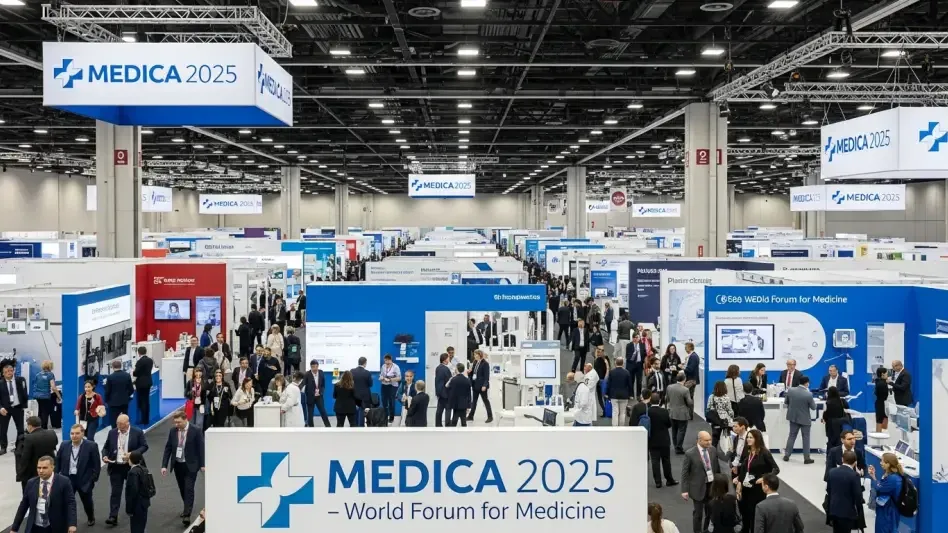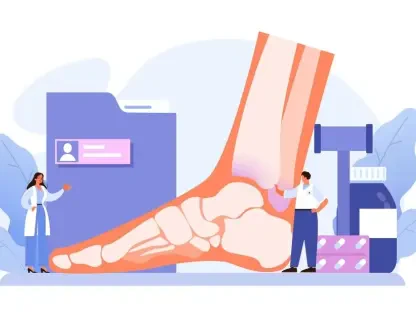In the high-stakes world of neonatal care, transporting vulnerable infants safely and efficiently remains a critical challenge for healthcare systems globally, with thousands of newborns requiring emergency transfers each year. The demand for innovative solutions that prioritize safety, mobility, and affordability has never been more pressing. Advanced Healthcare Technology Ltd (AHT), a UK-based innovator, steps into this arena with its groundbreaking BabyPod system, showcased at MEDICA in Dusseldorf, Germany, within the UK Pavilion hosted by Medilink UK. This report delves into how BabyPod addresses longstanding issues in infant transport and explores its potential to reshape industry standards through cutting-edge design and strategic visibility at one of the world’s leading medical trade fairs.
The State of Infant Transport in Healthcare Today
Infant transport within healthcare is a specialized field that demands precision and reliability to protect the most fragile patients during critical transfers. Neonatal and pediatric transport systems are integral to ensuring that infants, often in life-threatening conditions, reach specialized care units without compromise. Key market players, including established manufacturers of incubators and emergency transport equipment, dominate this space, yet gaps in accessibility and adaptability persist, particularly for under-resourced regions.
Technological advancements have begun to reshape this landscape, with innovations focusing on lighter materials, enhanced thermal regulation, and integration with various transport modes. However, challenges remain significant—hospitals and emergency services often grapple with bulky, expensive equipment that limits mobility and strains budgets. Additionally, maintaining a stable environment for infants during transit, especially over long distances, continues to test existing solutions, highlighting the urgent need for more practical and cost-effective alternatives.
Unveiling BabyPod: A Game-Changing Innovation
Unique Features and Design Advantages
At the forefront of infant transport innovation, BabyPod by AHT introduces a remarkable blend of safety and practicality tailored for neonatal and pediatric needs. Weighing under 10 kg, its carbon-composite construction—drawing from aviation and motorsport engineering—ensures a lightweight yet robust frame, easily compatible with standard stretchers in ambulances and aircraft. Crash-tested to endure a 10g load under the stringent European ambulance standard CEN 1789, BabyPod sets a high bar for safety in transit.
Beyond durability, the system incorporates BP37 technology for thermal support, maintaining a stable environment for up to 6 hours during transfers. A transparent lid allows continuous patient monitoring, while provisions for ventilation and monitoring equipment enhance clinical oversight. These features collectively position BabyPod as a versatile tool, adept at meeting the rigorous demands of emergency transport across diverse scenarios.
Accessibility and Cost-Effectiveness
One of BabyPod’s most compelling attributes is its pricing strategy, which challenges the status quo of prohibitively expensive transport incubators. By offering a more affordable alternative without sacrificing quality, AHT aims to democratize access to advanced infant transport solutions. This approach holds particular promise for low-resource settings, where traditional equipment costs often remain out of reach for many facilities.
The system’s adaptability further amplifies its value, catering to a wide range of environments from urban hospitals to rural emergency services. Its design facilitates seamless integration into existing transport infrastructures, whether by road or air, ensuring that even smaller or less-funded organizations can adopt this technology. Such accessibility could significantly broaden the reach of quality care for vulnerable infants worldwide.
Challenges in Infant Transport and BabyPod’s Solutions
Infant transport systems have long faced hurdles such as exorbitant costs, cumbersome equipment, and the difficulty of maintaining thermal stability during extended journeys. These issues often result in delayed or compromised care, particularly when equipment cannot be easily moved or adapted to different transport vehicles. For many healthcare providers, balancing operational efficiency with patient safety remains an ongoing struggle.
BabyPod directly confronts these pain points with its innovative design, prioritizing affordability through a cost-effective model that rivals traditional incubators. Its lightweight structure enhances mobility, while thermal regulation technology ensures infants remain stable regardless of transit duration. Though potential limitations, such as the need for broader compatibility with niche transport setups, may exist, AHT appears poised to address these through ongoing refinements and user feedback, ensuring the system evolves to meet diverse needs.
The adaptability of BabyPod to both road and air transport modes further underscores its problem-solving capacity. By reducing the logistical barriers that often hinder effective infant transfers, this system offers a practical alternative that could redefine operational protocols. As AHT continues to iterate on its design, BabyPod stands as a promising step toward overcoming entrenched challenges in this critical field.
Regulatory Standards and Safety Compliance
The regulatory landscape for infant transport devices is rigorous, with standards like the European ambulance benchmark CEN 1789 playing a pivotal role in ensuring equipment reliability. Compliance with such frameworks is non-negotiable, as they provide a foundation for safety during high-risk transfers. These standards test devices under extreme conditions, validating their ability to protect patients in emergencies.
BabyPod’s adherence to CEN 1789, including crash testing for 10g loads, establishes it as a leader in safety compliance within the industry. This commitment not only demonstrates AHT’s dedication to quality but also sets a precedent for other manufacturers to elevate their standards. Such rigorous testing reassures healthcare providers of the system’s dependability in real-world scenarios.
Building trust among medical professionals hinges on consistent compliance with these regulations. By meeting and exceeding industry benchmarks, BabyPod fosters confidence in its application across various settings, from urban trauma centers to remote emergency responses. This focus on safety is a cornerstone of its potential to gain widespread adoption and influence future regulatory expectations.
The Future of Infant Transport: BabyPod’s Role at MEDICA
MEDICA in Dusseldorf, hosted within the prominent UK Pavilion by Medilink UK in Hall 16, offers an unparalleled platform for BabyPod to capture global attention. This event, drawing industry leaders, policymakers, and practitioners to explore cutting-edge solutions. BabyPod’s presence, supported by Medilink UK’s expertise and efforts to drive visitor engagement, positions AHT to forge impactful partnerships and expand its reach.
Emerging trends in healthcare technology, such as the integration of advanced materials from aviation and motorsport into medical devices, are exemplified by BabyPod’s design. This convergence highlights a broader shift toward lightweight, high-performance equipment that prioritizes patient outcomes. The system’s showcase at MEDICA aligns with this momentum, illustrating how cross-industry innovations can address longstanding medical challenges.
Further amplifying the event’s significance is the participation of the first official NHS and NHS Scotland delegation, enhancing the UK’s visibility as a hub for healthcare advancements. BabyPod’s exposure at this venue could catalyze discussions on future standards for infant transport, potentially influencing global protocols. The networking opportunities at MEDICA provide a springboard for AHT to shape industry conversations from 2025 onward, driving progress in neonatal care delivery.
Final Thoughts
Reflecting on the insights gathered, BabyPod emerged as a transformative force in infant transport during its showcase at MEDICA. Its blend of lightweight design, stringent safety compliance, and affordability tackled critical gaps that had long plagued the sector. The strategic platform provided by Medilink UK within the UK Pavilion amplified AHT’s visibility, fostering connections that promised to extend BabyPod’s impact across international markets.
Looking ahead, stakeholders should prioritize collaboration with innovators like AHT to integrate solutions such as BabyPod into mainstream healthcare systems. Investment in scalable, accessible technologies must be paired with advocacy for updated safety standards that reflect these advancements. By focusing on these actionable steps, the industry can build on BabyPod’s momentum to ensure safer, more equitable transport for infants worldwide, addressing both current needs and future challenges with renewed vigor.









